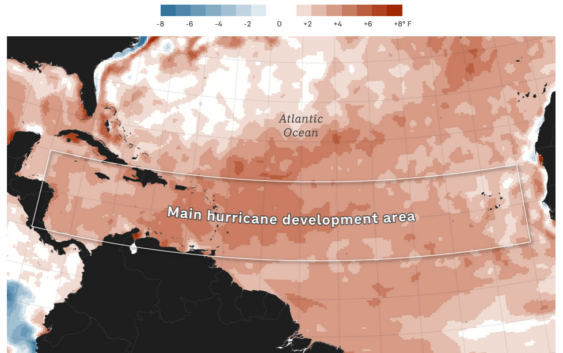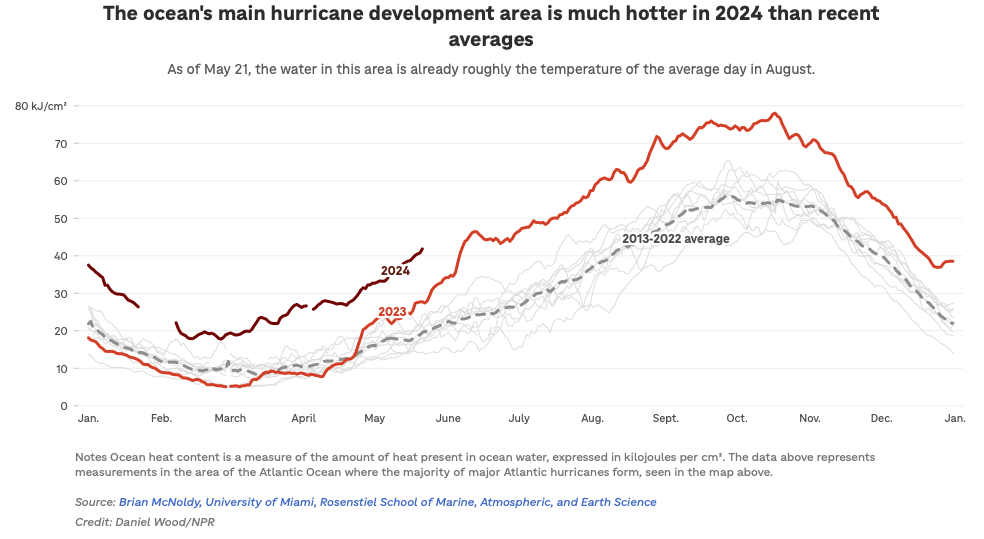- Report: Coastal flooding could threaten 1.4 million homes by midcentury
- Caught on camera | Tornado touches down in Missouri
- Carolina Hurricanes playoff tickets go on sale next week
- Storms kill 6 in the South and Midwest as forecasters warn of catastrophic rains, floods this week
- Weather Impact Alert: Cold front could trigger severe weather in Houston area this weekend | See timeline
The 2024 Atlantic hurricane season will be ‘extraordinary,’ forecasters warn

From NPR:
This year’s Atlantic hurricane season is expected to be extremely active, putting tens of millions of Americans in the eastern half of the country at risk from flooding and damaging winds, forecasters at the National Hurricane Center warn. The increased activity is partially caused by abnormally warm ocean temperatures driven by climate change.
Forecasters expect 17 to 25 storms to form in the Atlantic between June 1 and the end of November. At least 8 of those are forecast to be full-blown hurricanes, as opposed to weaker tropical storms. And 4 to 7 are expected to be major hurricanes, with winds powerful enough to uproot trees, destroy mobile homes and damage other buildings.
It’s the largest number of storms ever forecast for the Atlantic, and is well above the average of 14 storms that usually occur in a given hurricane season.
“This season is looking to be an extraordinary one,” says Rick Spinrad, the administrator of the National Oceanic and Atmospheric Administration, which houses the National Hurricane Center.
Hurricanes have caused massive damage and killed hundreds of people in the United States in recent years, as climate change makes powerful storms more common. Four of the last 5 years have had an above-average number of storms. In 2022, Hurricane Ian killed more than 150 people and caused more than $110 billion in damagewhen it hit Florida, and leveled entire neighborhoods in and around the town of Fort Myers Beach. In 2021, Hurricane Ida killed upwards of 100 people and caused an estimated $75 billion in damage from Louisiana all the way to New England.
Even relatively weak storms can cause catastrophic flooding, and the vast majority of hurricane-related deaths are from flooding, storm surge and other water hazards, warns National Weather Service director Ken Graham. In 2018, Hurricane Florence flooded the Carolinas despite being just a Category 1 storm with relatively low wind speeds. Hurricane Harvey was similarly weak when it stalled over the Houston region in 2017, causing massive flood damage.
People in the path of hurricanes should be prepared, and know where to evacuate and how to get there if a hurricane is bearing down on their home, forecasters and emergency managers stress.
“Think about what you need to do to protect yourself, your loved ones, and even your pets should a hurricane head your way this summer,” says Erik Hooks, deputy administrator at FEMA, the Federal Emergency Management Agency. “Do you have medication that requires refrigeration? Do you have a medical device that requires electricity? Do you have mobility challenges that make evacuations harder?”
One reason for the large number of expected storms is that wind conditions in the Atlantic and Caribbean are expected to be conducive to hurricane formation. Predicting wind conditions is difficult, but in years when the climate phenomenon known as La Niña is underway, winds are usually more favorable for hurricane formation. That’s because the vertical wind patterns, or wind shear, that disrupt hurricanes are less common.
While La Niña is not happening right now, it is expected to take hold by late summer, as peak hurricane season gets underway.
But the biggest factor is abnormally high water temperatures in the tropical Atlantic, where hurricanes form. Warm water is fuel for storms, because heat provides energy for the storm’s winds and warmer water provides more moisture, leading to large, powerful and rainy storms.

Climate change is the major driver of warming oceans worldwide, including in the Atlantic. The oceans have absorbed the vast majority of the extra heat that humans have trapped on Earth by burning fossil fuels.
But the current record-shattering warmth in the tropical Atlantic has also surprised and alarmed scientists. The temperatures are higher than would be expected from climate change alone, says climate scientist Gavin Schmidt, the director of NASA’s Goddard Institute for Space Studies.
“The warming that we’ve been seeing in the North Atlantic over the last year has made people kind of lift their eyebrows a little bit and go, ‘Huh! What’s going on there?’” Schmidt says.
Reductions in air pollution, recent volcanic eruptions and patterns of dust blowing off the Sahara desert could all be playing a role because tiny particles of pollution, ash and dust all affect how much of the sun’s heat is reflected in the atmosphere before it reaches the Earth’s surface, he says. Scientists around the world are currently working to understand these numerous, and complex, effects on ocean temperatures.